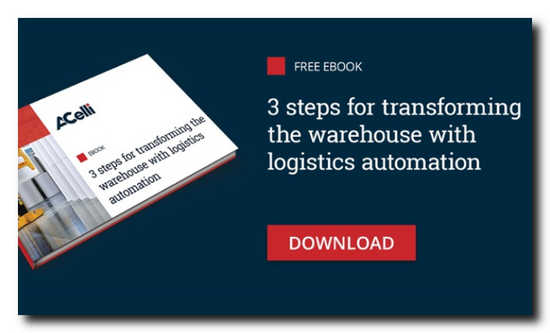Warehouse automation is the answer to the various problems associated with supply chains that need to be increasingly efficient and capable of handling many complex factors. E-commerce has made everything faster: from development and production to stock rotation and delivery. We need to be flexible and open to change, but also precise, because the customer has higher expectations than ever and is intolerant to error.
FREE EBOOK! >> 3 steps for transforming the warehouse with logistics automation
Then there are the costs of manual labour and maintaining the plants, which increase when the warehouse has to be expanded to take more stock. We now also commonly hear about connected objects, Big Data and analytics: these too are significant as they are the means for the transformation of many sectors (the agriculture and manufacturing industry, for example) and the flows of physical products are inextricably linked with data flows.
Logistics is not an island: the "4.0" transformation has also revolutionised this area, bringing automated tools for handling materials, robotics, sensors and data management and analysis software to the warehouses. Let us see, then, the main benefits of automation for warehouses.
10 advantages of warehouse automation +1
Some are immediate while others involve a longer return on investment. But the advantages of automation in warehouses all contribute in equal measure to improving the results of a business, allowing for lower costs and opening the way to new possibilities.
1. Speed and efficiency of operations
Automated shelving, shuttles, conveyor belts and automated guided vehicles (AGVs) all help to significantly reduce the time required to perform material handling operations. The loading capacity of the machines is without doubt superior to that of a team of warehouse workers, while sensors, decision points and management software create a "logic" for the workflows.
2. Increased productivity (even 24/7)
Depending on production and logistics requirements, machines can be used for long shifts, even without interruption at night. The dead times are eliminated, and the long operations of storage, handling and preparation of the orders are shortened.
3. Increased flexibility
Automation makes it possible to add resources without modifying the operating model, and with greater ease than human resources that, instead, have be recruited, integrated into the existing team and perhaps also given training. It is therefore easier to cope with seasonal peaks or grow the business, because automated storage is both modular and scalable.
4. Lower overheads
The optimisation of storage capacity, made possible with vertical warehouses, ensures clear savings in terms of rent and the cost of heating and cooling of rooms. The space is multiplied without increasing the surface area.
5. Lower personnel costs (and higher professional skills)
A single machine can do the work of several people on its own, but it still needs to be managed, supervised and maintained. No longer required to perform the most strenuous and repetitive tasks, employees can carry out work of a higher grade.
6. Standardisation and compliance
The definition of standard workflows in accordance with sector policies is another of the most obvious advantages of automation. With regard to safety, shuttles and AGVs in particular relieve the company of many responsibilities and its employees of the need to perform dangerous operations. Furthermore, sensors can be used to monitor the quality of the articles and the conformity of the processes.
7. Increased safety of operations
As mentioned above, entrusting certain tasks to machines and not to people is a fundamental strategy for ensuring safety at the workplace. The instruments in automated warehouses also guarantee "safety by design": they are designed to include bumpers, sensors, audible and luminous alarms that avoid collisions and protect both the warehouse personnel and the goods.
8. Integrity and hygiene of the goods
Devices such as shuttles and AGVs have hooks and gripping systems designed specifically to take palletised or packaged goods to their destination. The robots for handling rolls of paper and tissue, in particular, not only prevent accidental falls and tearing but also ensure total hygiene of the products, as there is no possibility of bacterial contamination during handling.
9. Visibility of goods and data flows
With warehouse automation, the work of collecting and transmitting the data obtained by the sensors is combined with the analytical capabilities of special software programs. The analysis of data (of production, storage, rotations, sales, costs, etc.) is useful for different reasons: it can be used to request automatic transfer from production to the warehouse, to ensure constant temperature in an environment or, again, to identify any issues. The collection of data also permits tracking of the stored material in real time. Moreover, patterns and interdependencies can emerge that cannot be identified with simple "empirical" observation of daily activities.
10. Predictive maintenance
The sensors on automatic vehicles or located at strategic points of the warehouse measure and monitor smooth running of operations. A decline in performance and anomalies alert to potential issues which can be averted with the predictive maintenance software provided.
And in addition to the advantages listed so far is one major plus: technological innovation and the transformation of operating models is a reflection of a mentality both bold and open to change, which certainly plays in favour of the corporate image.
How to make the most of automation
The main advantages of warehouse automation can be summarised as follows:
- for operations: flexibility, efficiency, accuracy, savings, predictive maintenance, compliance with industry standards and rules;
- for employees: improved safety and a better grade of work;
- for customer service: prompt and precise deliveries, and shorter order-delivery cycle;
- for strategies: monitoring of processes, tracking of patterns and data-based business intelligence.
Before considering the benefits for your warehouse, it is important to understand where to start. We are here to help you with our eBook, downloadable free of charge, which explains the 3 steps for transforming the warehouse with logistics automation!

